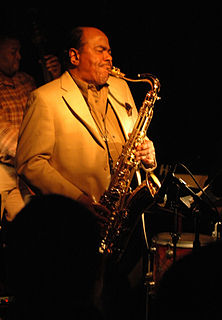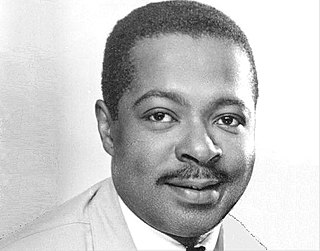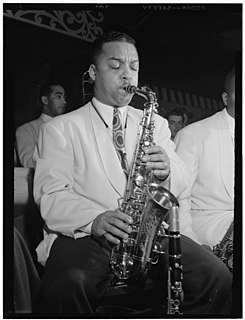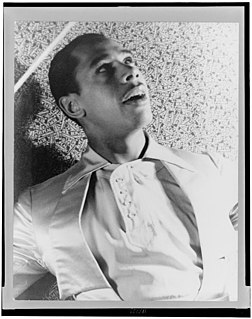Related Research Articles

Frederick Dewayne Hubbard was an American jazz trumpeter. He played bebop, hard bop, and post-bop styles from the early 1960s onwards. His unmistakable and influential tone contributed to new perspectives for modern jazz and bebop.

Bennett Lester Carter was an American jazz saxophonist, clarinetist, trumpeter, composer, arranger, and bandleader. With Johnny Hodges, he was a pioneer on the alto saxophone. From the beginning of his career in the 1920s, he worked as an arranger including written charts for Fletcher Henderson's big band that shaped the swing style. He had an unusually long career that lasted into the 1990s. During the 1980s and '90s, he was nominated for eight Grammy Awards, which included receiving a Lifetime Achievement Award.

Benny Golson is an American bebop/hard bop jazz tenor saxophonist, composer, and arranger. He came to prominence with the big bands of Lionel Hampton and Dizzy Gillespie, more as a writer than a performer, before launching his solo career. Golson is known for co-founding and co-leading The Jazztet with trumpeter Art Farmer in 1959. From the late 1960s through the 1970s Golson was in demand as an arranger for film and television and thus was less active as a performer, but he and Farmer re-formed the Jazztet in 1982.
Cool jazz is a style of modern jazz music that arose in the United States after World War II. It is characterized by relaxed tempos and lighter tone, in contrast to the fast and complex bebop style. Cool jazz often employs formal arrangements and incorporates elements of classical music. Broadly, the genre refers to a number of post-war jazz styles employing a more subdued approach than that found in other contemporaneous jazz idioms. As Paul Tanner, Maurice Gerow, and David Megill suggest, "the tonal sonorities of these conservative players could be compared to pastel colors, while the solos of [Dizzy] Gillespie and his followers could be compared to fiery red colors."

Stanley Getz was an American jazz saxophonist, professionally known as Stan Getz. Playing primarily the tenor saxophone, Getz was known as "The Sound" because of his warm, lyrical tone, with his prime influence being the wispy, mellow timbre of his idol, Lester Young. Coming to prominence in the late 1940s with Woody Herman's big band, Getz is described by critic Scott Yanow as "one of the all-time great tenor saxophonists". Getz performed in bebop and cool jazz groups. Influenced by João Gilberto and Antônio Carlos Jobim, he popularized bossa nova in the United States with the hit single "The Girl from Ipanema" (1964).

Jazz at the Philharmonic, or JATP (1944–1983), was the title of a series of jazz concerts, tours and recordings produced by Norman Granz.

Ben Pollack was an American drummer and bandleader from the mid-1920s through the swing era. His eye for talent led him to employ musicians such as Benny Goodman, Jack Teagarden, Glenn Miller, Jimmy McPartland, and Harry James. This ability earned him the nickname the "Father of Swing".

The alto saxophone, also referred to as the alto sax, is a member of the saxophone family of woodwind instruments. Invented by Belgian instrument designer Adolphe Sax in the 1840s and patented in 1846, it is pitched in E♭, smaller than the tenor but larger than the soprano. It is the most common saxophone and is commonly used in popular music, concert bands, chamber music, solo repertoire, military bands, marching bands, and jazz. The fingerings of the different saxophones are all the same, so a saxophone player can play any type of saxophone.

Leon Konitz was an American composer and alto saxophonist.

Philip Wells Woods was an American jazz alto saxophonist, clarinetist, bandleader, and composer.

Robert Henry Timmons was an American jazz pianist and composer. He was a sideman in Art Blakey's Jazz Messengers for two periods, between which he was part of Cannonball Adderley's band. Several of Timmons' compositions written when part of these bands – including "Moanin'", "Dat Dere", and "This Here" – enjoyed commercial success and brought him more attention. In the early and mid-1960s he led a series of piano trios that toured and recorded extensively.

Christian McBride is an American jazz bassist, composer and arranger. He has appeared on more than 300 recordings as a sideman, and is a seven-time Grammy Award winner.
Benny Green was a British jazz saxophonist who was also known for his radio shows and books.

Wynton Charles Kelly was an American jazz pianist and composer. He is known for his lively, blues-based playing and as one of the finest accompanists in jazz. He began playing professionally at the age of 12 and was pianist on a No. 1 R&B hit at the age of 16. His recording debut as a leader occurred three years later, around the time he started to become better known as an accompanist to singer Dinah Washington, and as a member of trumpeter Dizzy Gillespie's band. This progress was interrupted by two years in the United States Army, after which Kelly worked again with Washington and Gillespie, and played with other leaders. Over the next few years, these included instrumentalists Cannonball Adderley, John Coltrane, Hank Mobley, Wes Montgomery, and Sonny Rollins, and vocalists Betty Carter, Billie Holiday, and Abbey Lincoln.

Russell Procope was an American clarinetist and alto saxophonist who was a member of the Duke Ellington orchestra.
Albert J. "Budd" Johnson III was an American jazz saxophonist and clarinetist who worked extensively with, among others, Ben Webster, Benny Goodman, Big Joe Turner, Coleman Hawkins, Dizzy Gillespie, Duke Ellington, Quincy Jones, Count Basie, Billie Holiday and, especially, Earl Hines.
Murray McEachern was a Canadian jazz trombonist and alto saxophonist, perhaps best known for having played trombone for Benny Goodman from 1936 to 1937. McEachern is also remembered for playing both the trombone and alto saxophone for the Casa Loma Orchestra from 1937 to 1941.
Benny Krueger was an American jazz saxophonist.

This is a timeline documenting events of Jazz in the year 1933.
Porter Kilbert was a jazz alto and tenor saxophonist.
References
- ↑ Howard Rye, "Bumps Myers". The New Grove Dictionary of Jazz . 2nd edition, ed. Barry Kernfeld.